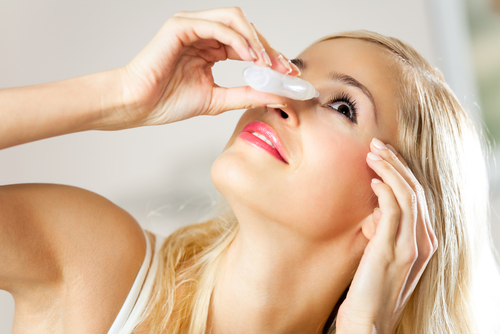
If you suffer from dry, itchy eyes, it may feel like you can never get any relief. Add in allergy season and pollen, and it gets even worse!
But it can be hard to know if you have dry eyes, allergies, or both. Not only that but if you have dry eye, are there treatments that work?
Keep reading for some tips to soothe your dry eye symptoms!
What is dry eye?
There are many factors that can cause dry eye. Dry eye often occurs because you are not producing enough tears or the tears that your eyes are producing are unstable. Blinking distributes tears over the surface of our eyes, keeping vision smooth and clear.
Tears are composed of three components: oil, mucus, and water. For tears to effectively keep our eyes healthy and lubricated, these components need to be balanced.
For those with dry eye, it’s common that tears are low quality because they do not have enough oil in them. Without enough oil, the tear film is unable to cover the front of the eye.
This is why one of the most common symptoms with dry eye is the blurry or distorted vision. This may get better after you blink a few times.
Do at-home dry eye treatments work?
This depends entirely on the severity of your dry eye symptoms. The most common dry eye symptoms include:
- dryness
- blurry, distorted vision
- feeling like there is grit or sand in your eye
- bloodshot eyes
- eyes that are overly watery
- tired or fatigued eyes
- sensitivity to light
Artificial tears
If your eyes are dry, the first thing you should do is lubricate them. The simplest way to do this is with artificial tears.
Your eye doctor can tell you which over the counter artificial tears are right for you. It can be very overwhelming to try to decide which brand to buy from the multitude of options at your local grocery store or pharmacy, and they are not all created equal!
Be sure to stay away from eye drops that “get the red out” as many of these can actually be harmful to your eyes.
Limit your screen time
There’s almost no way to avoid screens these days, but you should still try to limit your screen time. If your eyes are dry, staring at screens is only going to tire them out more. Looking at screens all day also leads to eye strain and fatigue, which go hand-in-hand with dry eye. If you have to use screens, whether for work or leisure, take frequent breaks. This means leave your desk and the screens for a few minutes! Go outside and get some fresh air.
You should also try to practice the 20-20-20 rule. Every 20 minutes, look away from your screen at a point that’s 20 feet away for 20 seconds. If you don’t think you’ll remember to take breaks, set a reminder on your phone.
Eat and drink to stay hydrated
Did you know that there are other ways to stay hydrated besides drinking water all day? What you eat can help you stay hydrated as well.
If you suffer from dry eye, it’s important to try and stay hydrated in any way you can! The next time you go grocery shopping, see if you can pick up some of these water-rich foods:
- Watermelon
- Peaches
- Cucumbers
- Zucchini
- Tomatoes
- Cauliflowers
- Grapefruit
- Plain yogurt
You may have been adding these water-rich foods into your diet and didn’t even know it! Besides eating water-rich foods, you should also be drinking enough water every day.
How much water you should be drinking every day varies, but at the least, you should be drinking eight 8oz glasses of water daily.
Adjust your environment
Another thing you can do if you’re dealing with symptoms of dry eye is adjusting your environment. This can mean a few things.
If you’re a smoker, stop. Smoking is one of the worst things for dry eye, as it dries your eyes out even further, increases redness, and leads to more damage. Smoking is also related to other eye diseases, so the benefits of quitting even go beyond dry eyes!
If you have dry eyes, no matter what time of the year it is, you should wear sunglasses outside. Yes, they protect your eyes from the sun’s rays, but they also protect your dry eyes from particles and allergens.
It’s obviously hot in Houston, so fans and air conditioning are a must this time of year! Just be sure that you don’t have vents or fans blowing directly in your face, as this will exacerbate your dry eye symptoms. You may also consider turning off the ceiling fan at night if this is making your eyes feel worse.
When is it time to seek dry eye treatment?
If you suffer from even mild dry eye, it’s time to come to Diagnostic Eye Center in Houston, TX to discuss your dry eye treatment options. Before we come up with a treatment plan, we’ll figure out what’s causing your dry eye. It is important to get the right treatment plan started early, as more severe dry eye may take longer to treat.
Some of the more common dry eye treatments include:
Omega 3 Supplements
Remember how most dry eye symptoms are due to an unstable tear film? This is because our tears are lacking in the oily component they need. Omega 3 supplements are vital to stabilizing the tear film and help treat dry eye at the root of the problem. Not all supplements are created equal, so talk to your doctor about which brand and dosage are right for you.
Punctal plugs
Punctal plugs are small collagen or silicone inserts that are placed into the punctum, or drain, of the eyelid. They can be temporary (dissolvable) or permanent. Plugs help tears stay in the eyes for longer, allowing nutrients from your tears to stay in your eyes.
Lipid-based artificial tears
These are artificial tears that target MGD, or meibomian gland dysfunction. A lipid-based tear is closer in composition to the tear film than a water-based tear.
MGD is often part of the dry eye syndrome diagnosis since dry eye and MGD go hand in hand and have similar symptoms.
Ready to say goodbye to your dry eye symptoms? Schedule an appointment at Diagnostic Eye Center in Houston, TX today!
It’s time to enjoy what you’re seeing again!

